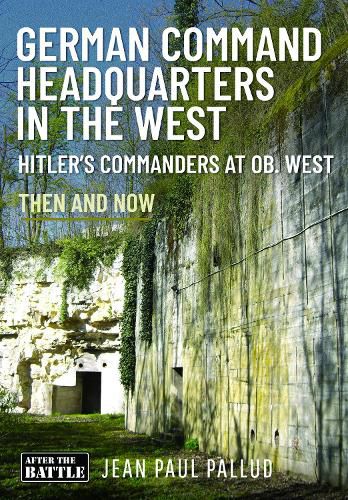Readings Newsletter
Become a Readings Member to make your shopping experience even easier.
Sign in or sign up for free!
You’re not far away from qualifying for FREE standard shipping within Australia
You’ve qualified for FREE standard shipping within Australia
The cart is loading…






The Wehrmacht won a quick victory in the West in 1940, the Netherlands and Belgium capitulated in May, and France signed an armistice on June 22. Heeresgruppe A remained in France and Generalfeldmarschall Gerd von Rundstedt and his staff established themselves at Saint-Germain-en-Laye and they soon worked on drawing up provisional instructions for Operation 'Seeloewe', the invasion of Great Britain. In October, von Rundstedt was appointed Commander-in-Chief West (Oberbefehlshaber West or Ob. West for short) and made responsible for all the German-occupied territory in western Europe. In April 1941, he and his staff were secretly moved to the East to take command of the right wing of the offensive against Russia and the function of Ob. West was taken over by Generalfeldmarschall Erwin von Witzleben. In March 1942 von Witzleben took leave of his command due to ill health and from the 8th, von Rundstedt returned as Commander-in-Chief in the West. It was from Saint-Germain that the Ob. West, von Rundstedt, faced the Allied landing in Normandy in June 1944, the invasion as the Germans called it. The German forces were unable to stop the Allied operation, Hitler found fault with the local commanders and decided to relieve von Rundstedt of his command. Generalfeldmarschall Guenther von Kluge was then appointed Ob. West and it was a grim situation that he inherited upon his arrival at Saint-Germain on July 3. Saint-Germain thus saw four of the most important Field Marshals of the Third Reich successively assuming command of the Ob. West, and a fifth, the famous Erwin Rommel, was also part of the story. Of these five Generalfeldmarschalls, three died for their involvement in the plot to eliminate Hitler, or for their sympathy with the conspiracy: von Witzleben was executed after an express judgment, and von Kluge and Rommel committed suicide. The Ob. West has left Saint-Germain with some remarkable constructions, most of which are still visible today, nestled in the city, witnesses to this strange episode in the history of the city. AUTHOR: Jean Paul Pallud was born in France in 1949 and studied physics at Grenoble University, graduating as a physicist engineer. Specialising in the history of the Second World War, he has worked alongside After the Battle for over 43 years, his first submission to the magazine appearing in 1979 and his last in 2022. 190 b/w illustrations
$9.00 standard shipping within Australia
FREE standard shipping within Australia for orders over $100.00
Express & International shipping calculated at checkout
The Wehrmacht won a quick victory in the West in 1940, the Netherlands and Belgium capitulated in May, and France signed an armistice on June 22. Heeresgruppe A remained in France and Generalfeldmarschall Gerd von Rundstedt and his staff established themselves at Saint-Germain-en-Laye and they soon worked on drawing up provisional instructions for Operation 'Seeloewe', the invasion of Great Britain. In October, von Rundstedt was appointed Commander-in-Chief West (Oberbefehlshaber West or Ob. West for short) and made responsible for all the German-occupied territory in western Europe. In April 1941, he and his staff were secretly moved to the East to take command of the right wing of the offensive against Russia and the function of Ob. West was taken over by Generalfeldmarschall Erwin von Witzleben. In March 1942 von Witzleben took leave of his command due to ill health and from the 8th, von Rundstedt returned as Commander-in-Chief in the West. It was from Saint-Germain that the Ob. West, von Rundstedt, faced the Allied landing in Normandy in June 1944, the invasion as the Germans called it. The German forces were unable to stop the Allied operation, Hitler found fault with the local commanders and decided to relieve von Rundstedt of his command. Generalfeldmarschall Guenther von Kluge was then appointed Ob. West and it was a grim situation that he inherited upon his arrival at Saint-Germain on July 3. Saint-Germain thus saw four of the most important Field Marshals of the Third Reich successively assuming command of the Ob. West, and a fifth, the famous Erwin Rommel, was also part of the story. Of these five Generalfeldmarschalls, three died for their involvement in the plot to eliminate Hitler, or for their sympathy with the conspiracy: von Witzleben was executed after an express judgment, and von Kluge and Rommel committed suicide. The Ob. West has left Saint-Germain with some remarkable constructions, most of which are still visible today, nestled in the city, witnesses to this strange episode in the history of the city. AUTHOR: Jean Paul Pallud was born in France in 1949 and studied physics at Grenoble University, graduating as a physicist engineer. Specialising in the history of the Second World War, he has worked alongside After the Battle for over 43 years, his first submission to the magazine appearing in 1979 and his last in 2022. 190 b/w illustrations